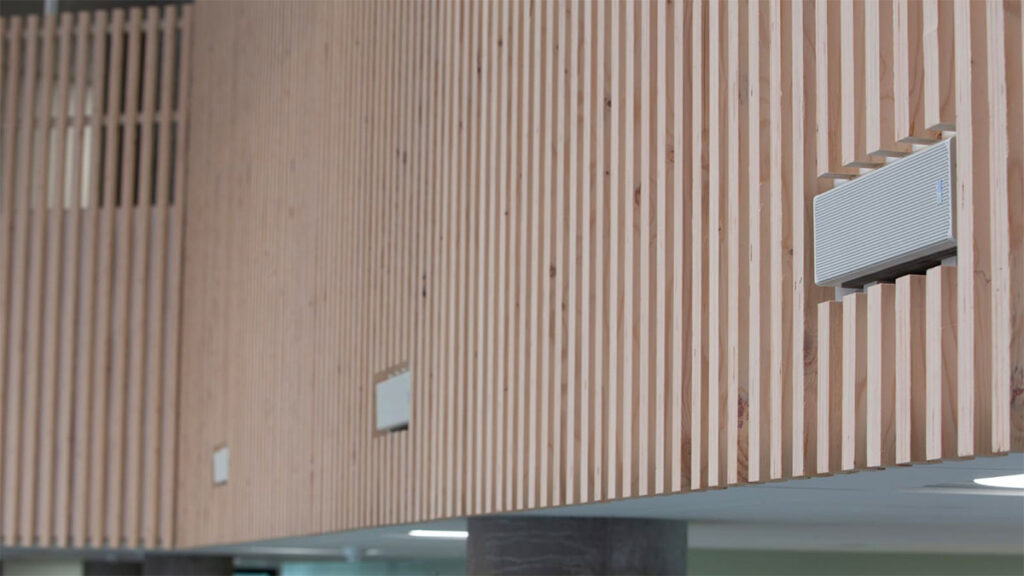Spacemap Go and Atmos Immersive Systems Unlock Limitless Possibilities.
When it opened in September of last year, the new campus of Sonic College — a unit of the University of South Denmark in Kolding — immediately vaulted to the top ranks of European educational institutions for all disciplines related to sound design for music, film, video, and gaming. The new facility boasts 10 state-of-the-art studios for sound creation, recording, and mixing, but what truly sets Sonic College apart is what the school calls their “sound-embracing atrium.” More than 180 Meyer Sound self-powered loudspeakers are installed throughout the five-story space, with about half facing into the open atrium and the remainder placed in the ceilings of connected corridors. Each loudspeaker is connected to a discrete output of a Galileo® GALAXY Network Platform, which allows dynamic panning of multiple sound sources throughout the entire space using Meyer Sound’s Spacemap® Go spatial sound design and mixing tool.
“We expect this is the largest permanent immersive sound installation of its kind anywhere in Europe,” says Lars Tirsbæk, a lecturer at Sonic College who played a key role in the design and equipping of the new campus. “The Spacemap Go system here gives students unique opportunities for creative experiments with spatial sound in a public environment. These could be music compositions, soundscapes, or interactive sound installations.”
The possibilities for creative spatial sound are virtually limitless. Multiple discrete sounds can be assigned to any loudspeaker or combination of loudspeakers, then dynamically panned vertically or laterally throughout the space, up and down in the atrium, or in and out of the adjoining corridors. The space is used regularly for student projects in experimental music and sound art.
But the atrium system also affords unique potential for exploring the realm of what might be called architectural psychoacoustics, the interface between enclosed spaces and the human experience of sound.

“Most atriums are acoustically difficult spaces,” notes Anders Jørgensen, the project manager for Stouenborg, the Danish AV integrator contracted for the system. “Students need to know not only how sound behaves in such environments, but also how people respond to the sounds. This research can lead to new applied technologies that can transform such spaces to make them more people-friendly, perhaps more relaxing and even inspiring.”
As a first step in this direction, the atrium system hosts a five-minute sound installation that runs twice daily. The ambient and atmospheric sounds (rain, wind, etc.) are automatically selected according to outside conditions, with the appropriate sounds triggered in QLab software for dynamic distribution via Spacemap Go.
“Having this permanent installation for research is something special,” says Tirsbæk. “With it, we have a unique opportunity to understand the long-term effects of introducing sounds into a public space. Yet we also can make small day-to-day changes, and then observe how people in the atrium respond to these changes.”
Sounds directed into the atrium space are reproduced with Meyer Sound UP‑4slim™ ultra-compact installation loudspeakers, between 13 and 15 per floor, with bass augmented by three USW-112P™ compact subwoofers per floor. A total of 90 Ashby-8C™ ceiling speakers carry the sounds laterally down corridors, with three-each ULTRA-X20™ and ULTRA-X22™ compact loudspeakers also integrated into the spatial sound system. Discrete sound placement and dynamic panning are implemented by a total of 12 Galileo® GALAXY 816 Network Platforms. All channels of the atrium system are directly accessible from the production studios via an AuviTran AVBx7 platform AVB to Dante conversion cards.
The Meyer Sound loudspeakers were supplied and installed by Stouenborg, which included the supervision of skilled riggers who dangled from the atrium ceiling while installing the overhead loudspeakers.
“To be honest, before the install I didn’t realize how important it was to have a self-powered solution,” continues Tirsbæk. “Just the amplifier rack space we would have needed would have been impossible to manage, not to mention the cooling needs! Also, the need for so many large cables for passive systems would have raised other difficult issues.”
Audio production for film, video, and gaming is a principal focus of instruction, and for that purpose two mixing rooms, both configured for Dolby Atmos mixing and rendering, are equipped with Meyer Sound cinema systems sold by Nordic Pro Audio and installed by Sonic College. The loudspeaker complement for the 80-seat mixing and dubbing stage comprises LCR screen channels each with an Acheron® Designer loudspeaker, with HMS-5™ surround loudspeakers, X-800C™ cinema subwoofers for LFE, and USW-112P compact subwoofers for surround bass management.
The smaller Dolby Atmos Mastering Suite also is equipped with Acheron Designer screen speakers and HMS-5 surround loudspeakers, but with X-400C™ cinema subwoofers for LFE.
“I had several conversations with professionals from the film industry, asking which loudspeakers they preferred,” recalls Tirsbæk. “The answers were quite one-sided: they preferred Meyer Sound. So, we had a tender, did some listening, and the rest is history.”
A division of the University of South Denmark (UC SYD), Sonic College offers a broad range of career-oriented programs in sound design, composition media production, game audio, project management, and related fields of study. The atrium project was funded in large part by a grant from AP Møller and Hustru Chastine Mc-Kinney Møller’s Foundation. At Integrated Systems Europe 2023, Sonic College won an Inavation Award in the “Education” category.